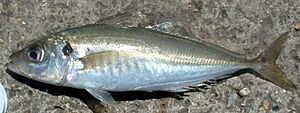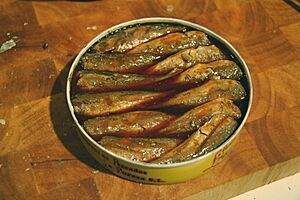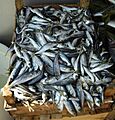Atlantic horse mackerel facts for kids
Quick facts for kids Atlantic horse mackerel |
|
|---|---|
 |
|
| Conservation status | |
| Scientific classification | |
| Synonyms | |
|
The Atlantic horse mackerel (Trachurus trachurus) is a type of fish found in the Atlantic Ocean. People also call it the European horse mackerel or common scad. It belongs to the Carangidae family, which includes other fish like jacks and pompano. This fish is important for fishing. Sadly, it is listed as a Vulnerable species because its numbers are decreasing.
Contents
- What Does the Atlantic Horse Mackerel Look Like?
- Where Do Atlantic Horse Mackerel Live?
- Life and Habits of the Atlantic Horse Mackerel
- How Did the Atlantic Horse Mackerel Get Its Name?
- Fishing for Atlantic Horse Mackerel
- Protecting the Atlantic Horse Mackerel
- How People Use Atlantic Horse Mackerel
- Images for kids
What Does the Atlantic Horse Mackerel Look Like?
The Atlantic horse mackerel has a slim body. Its head is quite large. The lower jaw sticks out a bit more than the upper jaw. Its eyes have a special fatty eyelid.
This fish has two dorsal fins on its back. The first one is tall and spiky. The second one is longer and softer. It also has an anal fin on its underside. This fin is about the same length as the second dorsal fin.
A curved line of bony plates, called scutes, runs from its head to its tail. These scutes get bigger and bonier near the tail. The fish is dark blue on top. Its sides are silvery, and its belly is white. It has a dark spot on its gill cover.
Atlantic horse mackerel can grow up to 60 centimetres (24 in) long. But they are usually around 25 cm (10 in). They can weigh up to 1.5 kg (3 lb).
Where Do Atlantic Horse Mackerel Live?
You can find Atlantic horse mackerel in the northern and eastern Atlantic Ocean. They also live in the Mediterranean Sea, the Sea of Marmara, and the Black Sea. In the Atlantic, they are found from Norway all the way to South Africa. Sometimes, they even go around the Cape of Good Hope into the Indian Ocean.
They have been seen near Cape Verde. However, they are thought to be rare visitors there.
Life and Habits of the Atlantic Horse Mackerel
Atlantic horse mackerel usually live near the seabed. They prefer sandy areas. They are often found at depths of 100–200 m (50–110 fathoms; 330–660 ft). Sometimes, they can be found much deeper, even up to 1,050 m (570 fathoms; 3,440 ft). They can also swim closer to the surface.
These fish are migratory. This means they travel long distances. They move north in the summer when the water is warmer. When the sea gets colder, they travel back south.
In the North Sea, there are two main groups of these fish. One group lays its eggs from Ireland to the Bay of Biscay in early spring. Then they move north to Norway and the northern North Sea for summer. The other group lays eggs in the southern North Sea during summer. They then move north to the central North Sea.
Female fish lay their eggs in batches. Each batch can have up to 140,000 eggs. The tiny baby fish, called larvae, are about 5 mm (3⁄16 in) long when they hatch. Both the eggs and larvae float freely in the water.
Young Atlantic horse mackerel often swim together. They might join groups of other young fish. These can include Atlantic herring or other types of horse mackerel. Young fish are also often seen hiding among the tentacles of jellyfish for safety.
In South Africa, these fish can live up to 24 years. In the northeast Atlantic, some have lived for 40 years. Females usually start breeding when they are two to four years old.
What Do They Eat?
Both young and adult Atlantic horse mackerel eat small creatures. Their diet includes tiny copepods, shrimps, small fish, and squids.
Scientists studied the stomach contents of these fish. They found over 60 different types of prey. These included small worms, crustaceans (like crabs and shrimp), molluscs (like snails), and other small fish. Tiny crustaceans like copepods were the most common food. Small fish were also a very important part of their diet.
Larger Atlantic horse mackerel, especially those over 16.9 cm (6+5⁄8 in), mostly eat the larvae of other fish.
How Did the Atlantic Horse Mackerel Get Its Name?
The Atlantic horse mackerel is the main species in its group, called Trachurus. The scientific name Trachurus comes from two Greek words. Trachys means "rough," and oura means "tail." This name likely refers to the spiny plates on its tail section.
The common name "horse mackerel" has an interesting story. Some people thought it was because other fish rode on its back. But it might come from an old Dutch word, Horsmakreel. This word meant a mackerel that lays its eggs over a shallow area or bank. This Dutch word then became "horse mackerel" in English.
Fishing for Atlantic Horse Mackerel
People fish for Atlantic horse mackerel for food. They use different methods like large nets called trawls. They also use longlines, purse seines (nets that close like a purse), and traps.
In 1999, a report showed that over 322,000 tonnes of this fish were caught. The biggest catches were in the Netherlands and Ireland. There are rules about how many fish can be caught in the North Sea. However, the actual catches have often been below these limits. Experts say that the limits are not always based on the best scientific advice.
There are calls to create a better plan for managing Atlantic horse mackerel fishing. This would help make sure that enough fish remain for the future.
Protecting the Atlantic Horse Mackerel
The IUCN (International Union for Conservation of Nature) lists the Atlantic horse mackerel as a Vulnerable species. This means its population is at risk. Even though numbers in European waters haven't dropped much, there have been big declines off the West African coast.
Scientists estimate that the population has decreased by at least 35-40% over the last 30-35 years. The International Council for the Exploration of the Sea (ICES) also says that the number of these fish is below a safe level for fishing. Their populations have been slowly declining. This is due to more fishing pressure and fewer young fish joining the population since 2004.
How People Use Atlantic Horse Mackerel
Atlantic horse mackerel is eaten fresh. It can also be preserved in different ways. People freeze it, salt and dry it, smoke it, or put it in cans. You can cook it by frying, broiling, or baking.
The meat is said to have a pleasant taste. It has an oily, delicate texture. It is also a good source of omega-3 fatty acids, which are healthy fats.
Here's what 100 grams of Atlantic horse mackerel meat provides:
- Water: 77.4 g
- Protein: 19.8 g
- Fat: 2 g
- Cholesterol: 64.4 mg
- Total minerals: 1.3 g
- Phosphorus: 224 mg
In Spain and Portugal, it might be prepared as an escabeche. This is a dish where the fish is marinated. Some are also sent to Japan. There, they are called aji and used to make sushi. They are also an important part of cooking in Sicily, Italy.
Images for kids






